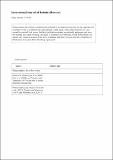A Kinematic Approach to Determining the Optimal Actuator Sensor Architecture for Space Robots
Author(s)
Boning, Peggy; Dubowsky, Steven
DownloadMain article (2.927Mb)
OPEN_ACCESS_POLICY
Open Access Policy
Creative Commons Attribution-Noncommercial-Share Alike
Terms of use
Metadata
Show full item recordAbstract
Autonomous space robots will be required for such future missions as the construction of large space structures and repairing disabled satellites. These robots will need to be precisely controlled. However, factors such as manipulator joint/actuator friction and spacecraft attitude control thruster inaccuracies can substantially degrade control system performance. Sensor-based control algorithms can be used to mitigate the effects of actuator error, but sensors can add substantially to a space system’s weight, complexity, and cost, and reduce its reliability. Here, a method is presented to determine the sensor architecture that uses the minimum number of sensors that can simultaneously compensate for errors and disturbance in a space robot’s manipulator joint actuators, spacecraft thrusters, and reaction wheels. The placement and minimal number of sensors is determined by analytically structuring the system into “canonical chains” that consist of the manipulator links and spacecraft with force/torque sensors placed between the space robot’s spacecraft and its manipulators. These chains are combined to determine the number of sensors needed for the entire system. Examples of one- and two-manipulator space robots are studied and the results are validated by simulation.
Date issued
2010-08Department
Massachusetts Institute of Technology. Department of Mechanical EngineeringJournal
International Journal of Robotics Research
Publisher
SAGE Publications
Citation
Boning, Peggy, and Steven Dubowsky. “A Kinematic Approach to Determining the Optimal Actuator Sensor Architecture for Space Robots.” The International Journal of Robotics Research : August, 2010.
Version: Author's final manuscript
ISSN
0278-3649
1741-3176